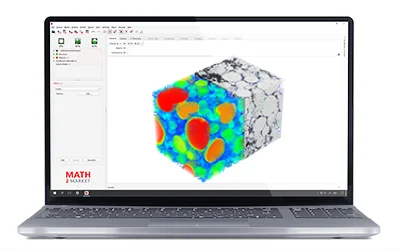When using renewable energy sources, the time point of generation and demand are rarely simultaneous. Whether solar, hydroelectric, or wind energy is to be used, the main challenge resides in the efficient intermediate storage of the generated energy.
The current state-of-the-art solutions involve the storage in form of chemical energy. In addition to batteries, the electrolytical conversion of water and the storage of the produced energy in the form of hydrogen play a pioneering role here. The stored energy can then be released again through a fuel cell. In addition to hydrogen, other fuels such as methanol or natural gas can be used.
Improvement potential lies in the microstructure
Whether it is an electrolyzer for hydrogen production, a polymer electrolyte fuel cell (PEMFC) or a solid oxide fuel cell (SOFC), each system places enormous demands on the properties of the component materials. In many of these areas, the next-generation of better performing materials have yet to be developed.
GeoDict offers a comprehensive solution for the development of fuel cells
GeoDict simulations address key issues in research and development of fuel cell materials and, particularly, for two-phase fluid flow properties.
GeoDict digitally generates realistic 3D models of the microstructure of materials used in electrolyzers and fuel cells (PEM, GDL, MPL, CL, electrodes). The material properties critical for the performance of these models are then characterized. The goal of the simulations is to optimize each material to fit to its requirements and to improve the performance of the energy materials.
Selected Clients of Fuel Cells
to Clients OverviewGeoDict provides a wide range of tools for the simulation and computation of relevant parameters in fuel cell research:
- Geometric parameters: Porosity, pore size distribution, surface area, length of contact lines, geodesic tortuosity.
- Conduction parameters: Thermal conductivity, thermal flux, temperature distribution, electrical conductivity, electrical flux, electrostatic potential distribution.
- Saturation parameters: Saturation exponent, capillary pressure curve, variable contact angles.
- Diffusion and flow parameters: Permeability, diffusivity, Gurley value, particle advection and diffusion, particle concentration.
GeoDict 2025 Innovationen für Wasserstoffanwendungen
Please note that after activating the video, data will be transmitted to YouTube.
More Information
Please note that after activating the video, data will be transmitted to YouTube.
More Information
Please note that after activating the video, data will be transmitted to YouTube.
More Information
Please note that after activating the video, data will be transmitted to YouTube.
More Information






























